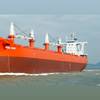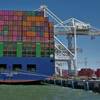According to reports, the Port of New Orleans is in dire need of federal and state aid to save some of its most damaged operations and businesses, the port's president and chief executive told the maritime industry in his annual state of the port address.
Gary LaGrange said the port is in a battle to retain the nine maritime businesses that operate along the Industrial Canal, a 1,000-acre tract of port property that was devastated by Hurricane Katrina. Together the businesses generated about 9,000 indirect jobs, LaGrange said.
At least one of them probably will have to relocate soon, he said.
The port does have several things to celebrate, he said. Despite early predictions that the port wouldn't receive its first cargo ship for six months, it received its first shipments two weeks after the storm. Five months later business has grown to about 60 percent of pre-Katrina levels. And for the past two weeks, the number of ships visiting the port's dock facilities equaled pre-Katrina levels, LaGrange said.
He estimates that by March 1, the numbers will show that cargo operations have returned to 70 percent to 80 percent of their pre-Katrina levels. Most companies on the Mississippi River were able to reopen just after the storm.
But about 30 percent of the port's businesses, nine companies on the Industrial Canal, continue to struggle. Those businesses relied on the Mississippi River-Gulf Outlet, which is effectively closed. The manmade channel reaching across St. Bernard Parish connecting Breton Sound to the Industrial Canal was a shortcut for deep-sea ships. The controversial channel was blamed for some post-Katrina flooding in St. Bernard. As a result, the Army Corps of Engineers, which maintains the outlet, suspended dredging for 18 months while it studies the channel's role in the flooding. Without the dredging, the channel doesn't provide clearance for deep-draft ships.
At least one port tenant, CG Railways, may be forced to leave New Orleans altogether because its ships are too wide to fit through the old lock system on the Industrial Canal. Traveling up the Mississippi River is too cost-prohibitive for the company.
Another firm, New Orleans Cold Storage, has to truck cargo from its warehouse on the Industrial Canal to ships docked at the Mississippi River because ships can't use the canal.
LaGrange said if the government helped pay for the Inner Harbor Navigational Canal lock project, Industrial Canal businesses might have some incentive to stay. The lock was authorized by Congress in 1956 but has never been funded. Just last week President Bush declined to dedicate money to the project.
He has asked for $260 million to $360 million to help defray businesses costs and pay for repairs. So far, the port has received no money from the federal government and only $5 million in business interruption insurance.
Citing an economic impact study conducted just before the storm, LaGrange said the agency pays more than $900 million in taxes to the state.
LaGrange also took Gov. Kathleen Blanco to task for a spending plan she announced recently that gives just $300 million to economic development statewide.
Meanwhile, other port industries continue to recover. Just after the port reopened after Katrina, its most immediate challenge was labor, specifically finding stevedores to load and unload ships and truck drivers to carry cargo into and out of the port. Some of those problems persist.
Source: Timespicayune.com
Featured videos

Unlock Onboard Data Efficiencies

Inmarsat Enhances Service to Drive Digitalization

Tracking Foreign Vessels Working in the U.S. Jones Act Market
Subscribe for
Maritime Reporter E-News
Maritime Reporter E-News is the maritime industry's largest circulation and most authoritative ENews Service, delivered to your Email five times per week









